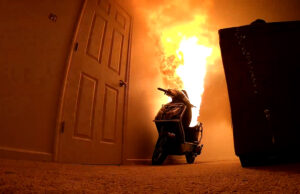ULRI Experts Warn ‘Chromebook Challenge’ Risks Fast and Intense Fires
Students who take part in TikTok’s “Chromebook challenge” aren’t just playing with fire — they’re risking lithium-ion battery fires that burn hotter and faster and are harder to extinguish than most other fires.
The recent social media trend has prompted students throughout the country to try to short-circuit their lithium-ion powered tablets or laptops by inserting lead or metal items like paperclips into one of the device’s ports. Fires caused by the viral challenge could be more severe than the students realize, UL Research Institutes experts warn.
“Lithium-ion battery fires are more intense than other fires and emit toxic gases,” said Steve Kerber, Ph.D., ULRI’s Fire Safety Research Institute vice president and executive director. “You could have very little time to escape this type of fire; students need to understand how hazardous this TikTok challenge is.”
That’s because a damaged lithium-ion battery can enter an uncontrollable, self-heating state known as thermal runaway, leading to battery swelling and venting, smoke, or fire, or a combination of these that results in toxic off-gassing.
“We are working to strengthen lithium-ion battery fire safety on a number of fronts, including research and global education,” said Judy Jeevarajan, Ph.D., ULRI’s Electrochemical Safety Research Institute vice president and executive director. “But these batteries can be dangerous if not handled correctly. Misuse or intentional abuse can overwhelm the protective controls even in high-quality, well-designed batteries and lead to thermal runaway.”
Understanding and mitigating lithium-ion battery risk
Lithium-ion batteries have become commonplace, powering household items from toothbrushes to cellphones and laptops. Still, many Americans are unfamiliar with lithium-ion battery thermal runaway risks, with 40% of respondents saying they were not aware of the risk in a September 2024 study conducted by UL Standards & Engagement.
A typical lithium-ion battery’s chemical system is stable but can be destabilized through electrical overcharge, excessive heat, or other mishandling like external short-circuiting.
“It is critical for all ages to understand thermal runaway and the steps they can take to protect their lithium-ion battery-powered devices,” said Kelly Keena, Ph.D., vice president and executive director of ULRI’s Institute for Research Experiences & Education. “Through our open-access education platform Xplorlabs, we’re focused on resources that help students understand the real-world safety risks around them, such as thermal runaway and fire, and the extreme risks challenges like this pose.”
Resources:
- What Is Thermal Runaway?
- What Are Lithium-Ion Batteries?
- Where Can You Find Lithium-Ion Batteries?
- FSRI introductory lithium-ion battery guide
- Take C.H.A.R.G.E. campaign
- Be Nice To Your Device
- ULRI’s Xplorlabs education platform for middle and high school students: Science of Thermal Runaway learning pathway









